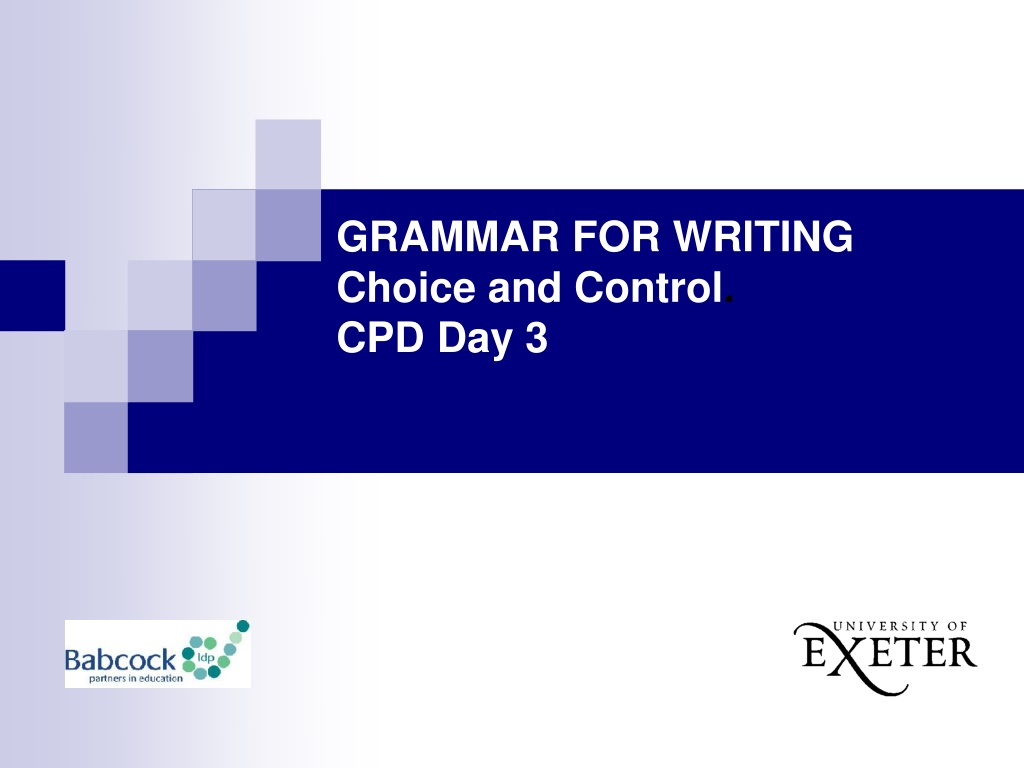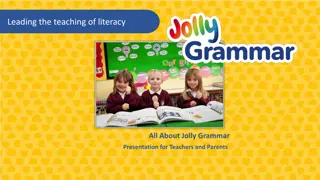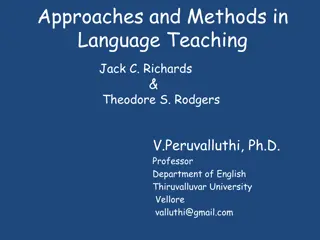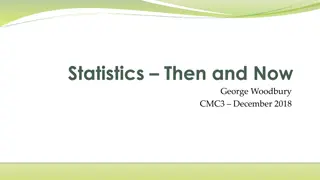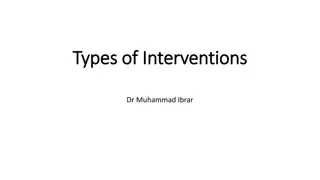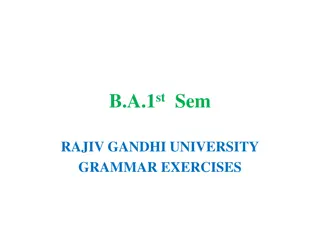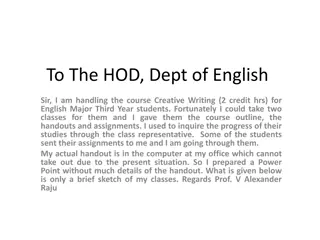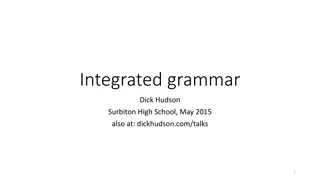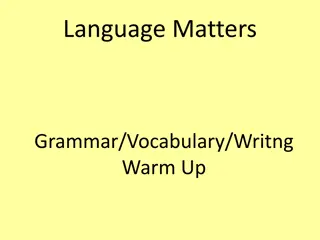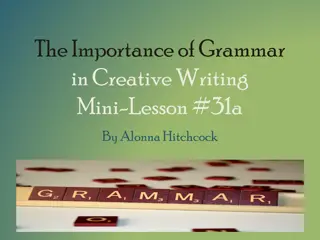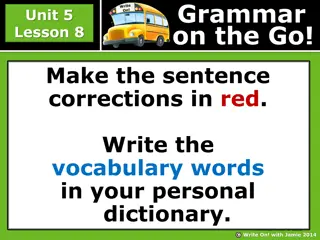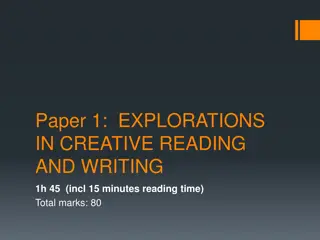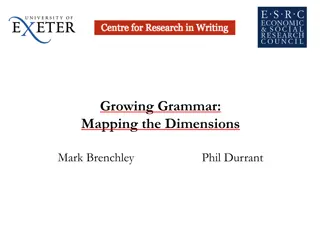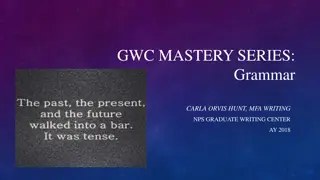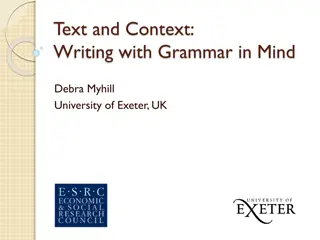Creative Teaching Approaches in Grammar and Writing Intervention
Re-iterating teaching principles for writing intervention, focusing on grammatical subject knowledge, adverbials, modal verbs, and passive voice. Emphasizing creative teaching methods for persuasive writing, fostering imagination, emotions, and personal beliefs in young writers. Incorporating space for exploration, experimentation, and re-drafting in writing processes. Utilizing real-life issues, collaborative writing, and public speaking practice in persuasive writing schemes of work.
Download Presentation

Please find below an Image/Link to download the presentation.
The content on the website is provided AS IS for your information and personal use only. It may not be sold, licensed, or shared on other websites without obtaining consent from the author. Download presentation by click this link. If you encounter any issues during the download, it is possible that the publisher has removed the file from their server.
E N D
Presentation Transcript
GRAMMAR FOR WRITING Choice and Control. CPD Day 3
Aims of Session: CPD Day 3 To re-iterate the teaching principles underpinning the writing intervention; To secure grammatical subject knowledge of adverbials, modal verbs, and the passive voice To understand the teaching approaches in the persuasive writing SoW. 3
GfW: Four Key Teaching Principles Make a link between the grammar being introduced and how it works in the writing being taught; Explain the grammar through examples, not lengthy explanations; Build in high-quality discussion about grammar and its effects. Use examples from authentic texts tolinks writers to the broader community of writers. 4
Teaching Writing Creatively To write well we all need to have something to say and a desire to say it; Before young writers can meaningfully attend to how they have written something, they need to have engaged with what they want to say the ideas; Engaging young writers imaginations, emotions and personal beliefs is a really important part of teaching writing; Allowing young writers freedom to explore ideas, test things out, and to write to find out what they want to say is critical We often move far too quickly to pinning things down, and making writing a very linear process we need to create space for exploration, experimentation and re-drafting. This is built into both of our Schemes of Work. 5
Teaching Writing Creatively Persuasive Writing: Scheme of Work Real life issue: connecting persuasive writing with an issue which they can understand, and which can be extended in the local context. Content input: video and text information to ensure the children have the information to be persuasive with;. On the Soapbox: practising written speech orally in an authentic persuasive context; generating confidence in public speaking; The Writing Process: gives space for idea generating, planning, outlining, drafting and revising throughout the scheme, with a particular emphasis on initial collaborative writing, then independent writing. 7
Modal verbs, adverbials and passive voice GRAMMAR SUBJECT KNOWLEDGE 8
Overview of the session: Using language devices to position the reader Adverbials Modal verbs Passive voice
Adverbs/Adverbials Subject Verb Object Adverbial Complement (adjective) / Complement (noun) Gregor ate bread greedily. Beauty s father was eating the extremely fresh bread. Gregor ate bread so greedily Surprisingly, Beauty s father was eating the freshly baked bread .
Activity in small groups Teachers demanding workload is growing.
A letter from the RSPB Look at the adverbs/adverbials identified in the text. What is each one trying to do? How do they position the reader?
Adverbs/adverbials: big ideas Adverbs/adverbials modify (almost everything) They provide additional information: Time Place Manner Reason Degree Some types link ideas across clauses, sentences or paragraphs (conjuncts and conjunctions) or comment on a whole clause or sentence (disjuncts) Adverbs/adverbials are often mobile within a sentence
Modal Verbs shall, should, can, could, might, may, must, will, would We ___________ open the door.
Kensukes Kingdom - Michael Morpurgo But I knew now I couldn t have been. I must have dreamed it, dreamed the whole thing. I must have clung to my football and kept myself afloat until I was washed up. From where I now stood I could see that the forest grew more sparsely up the side of a great hill some way inland, and it occurred to me then that ifI could reach the bare rocky outcrop at the summit. Or perhapsthere d be some house or farm further inland, or maybe a road, and I could find someone to help.
A letter from the RSPB Activity Find the modal verbs What is the effect on the reader? How are they used across the text?
Modal verbs: big ideas Type of auxiliary verb and help form verb phrases Always go before other auxiliaries (You could have heard; Time could be running out.) Express degrees of possibility and certainty (and therefore can be used to position a reader) Do not have an s form or non-finite forms (-ing, -ed, to - )
The Passive Voice Form Auxiliary verb be + past participle of the main verb. The pen was dropped.
The picture is painted. Modal Lexical/Main Auxiliary painted is was has been have been be may might can could will would must
Formation of passive Verb be + past participle The picture is painted (by the artist). The picture was painted. The picture will be painted. The picture is being painted. The picture was being painted. The picture has been painted. The picture had been painted. The picture might have been painted.
Passive Voice The door was pushed slowly open As the cable is wound in A rucksack was loaded on my back Where are the biscuits I bought yesterday? I don t know I think they ve been eaten. Thousands were made homeless. Rules are made to be broken.
Activity In your table group, work in pairs: Each pair read one of the texts Find examples of the passive voice Tell your whole group what effect the passive has and give an example
SV inversion: Other ways to create the same effects Delaying/distancing: passive voice Every corridor was lined with great gilded mirrors, each one cracked like broken ice. Every vase was filled with fresh flowers, every statue blindfolded with a scarf of silk. Beauty and the Beast Geraldine McCaughrean
Passive voice: big ideas Constructed with auxiliary verb be + past participle of the main verb Can create different effects for the reader Mystery and suspense Formality the agent is unimportant Abdication of responsibility Lack of control Focus on result of an incident, outcome or argument General truths
Overview of the session: Using language devices to position the reader Adverbials Modal verbs Passive voice
He swam to the bottom of the deepest ocean. He climbed to the tops of the tallest trees. whisper-thin wings of rainbow hues. 27
Developing the noun phrase by adding words after the main noun: post- modification Noun Adjective Relative clause Non Finite Clause Prepositional phrase dragon wings body spiky delicate rough scaly turquoise jade-green fierce with steel- grey spikes which rules the skyline towering above the world of immense strength who towers above the horizon, silhouetted against the darkening skies that terrorises the valleys
The Ice Bear Jackie Morris a piece of amber, smoothed by oceans, coloured, clear and beautiful, like a fragment of fire, washed ashore from a far off place. 29
The Ice Bear Jackie Morris a piece of amber, smoothed by oceans, coloured, clear and beautiful, like a fragment of fire, washed ashore from a far off place. 30
Resources to help you Essential Primary Grammar: Myhill, Jones, Watson & Lines (2016) No Nonsense Grammar: Babcock LDP Literacy Team, Raintree (2016) www.babcock-education.co.uk/ldp/literacy
Persuasive Writing FOOD WASTE: CAN YOU CHANGE THE WORLD? 32
SoW Overview This scheme of work focuses on developing students awareness of the need to craft and shape a persuasive text. Through collaborative joint composition and collaborative revision, it supports students in learning about the writing process and how to plan and revise. The scheme draws attention to some characteristics of a persuasive text, developing students understanding of 3 core issues. Task awareness: Who is the reader? What is the purpose of the text? What are the writer s authorial intentions? Content: What do we need to know about the topic of food waste to create a persuasive text? Grammar and Language Choices: How are we going to write the text? 33
Grammar-Writing Links Understanding how to create a persuasive argument through: Using clear statement sentences to make important points Using single clause sentences to draw attention to key points Choosing positioning vocabulary to indicate your point of view Choosing information, such as statistics, to support your point of view Using modal verbs to indicate different levels of assertion/possibility Choosing adverbs to reveal or emphasise your point of view Choosing connecting adverbials to link ideas across sentences 34
Being Persuasive These are all sentences from different reports on food waste. The writers have thought about how to be persuasive thinking about what they write and how they express it. With food bank visits at an all-time high, the amount supermarkets are throwing away is appalling. A survey reveals a staggering two thirds of some freshly bought food goes to waste. The average UK family is wasting nearly 60 a month by throwing away almost an entire meal a day. One third of all food produced in the world ends up as waste. 35
Being Persuasive These are all sentences from different reports on food waste. The writers have thought about how to be persuasive thinking about what they write and how they express it. With food bank visits at an all-time high, the amount supermarkets are throwing away is appalling. A survey reveals a staggering two thirds of some freshly bought food goes to waste. The average UK family is wasting nearly 60 a month by throwing away almost an entire meal a day. One third of all food produced in the world ends up as waste. The sentences are all clear statements which express the writer s point of view. 36
Being Persuasive They use vocabulary which emphasises the point of view. These are all sentences from different reports on food waste. The writers have thought about how to be persuasive thinking about what they write and how they express it. With food bank visits at an all-time high, the amount supermarkets are throwing away is appalling. A survey reveals a staggering two thirds of some freshly bought food goes to waste. The average UK family is wasting nearly 60 a month by throwing away almost an entire meal a day. One third of all food produced in the world ends up as waste. The sentences are all clear statements which express the writer s point of view 37
Being Persuasive They use vocabulary which emphasises the point of view. These are all sentences from different reports on food waste. The writers have thought about how to be persuasive thinking about what they write and how they express it. With food bank visits at an all-time high, the amount supermarkets are throwing away is appalling. A survey reveals a staggering two thirds of some freshly bought food goes to waste. The average UK family is wasting nearly 60 a month by throwing away almost an entire meal a day. One third of all food produced in the world ends up as waste. The sentences are all clear statements which express the writer s point of view They choose facts which support their point of view. 38
Being Persuasive You can sometimes make your point stronger by stating it using a short single clause sentence: With food bank visits at an all-time high, the amount supermarkets are throwing away is appalling. The amount of food waste from supermarkets is appalling. The average UK family is wasting nearly 60 a month by throwing away almost an entire meal a day. The average UK family throws away almost an entire meal a day. One third of all food produced in the world ends up as waste. One third of the world s food ends up as waste. 39
Being a Persuasive Writer There are many choices you can make as a writer to make your writing more persuasive and express your point of view strongly. We have been looking at: Making vocabulary choices which signal your point of view: eg appalling; staggering; waste; Using clear statement sentences to make important points: A survey reveals a staggering two thirds of some freshly bought food goes to waste. Choosing information which supports your point of view: One third of all food produced in the world ends up as waste. Using short single clause sentences to draw attention to your point: The amount of food waste from supermarkets is appalling. You can make choices as a writer which could persuade people to take action to change the world! 40
Words to Change the World Nouns: rubbish wastefulness disposal refuse environment consumer consumption perishables landfill produce suppliers exporters packaging emissions pollution resources Verbs squander misuse redistribute pollute Adjectives: nourishing unsold edible consumable mis-shapen imperfect 41
PERSUADING WITH MODAL VERBS 42
Modal Verbs must can will may would shall should could might ought to loud You canhave chocolate after dinner. Turning up the volume: modal verbs can be used for gentle persuasion or strong persuasion, like turning up or turning down the volume on the television soft 43
Modal Verbs can could will would shall should may might must ought to they simply cannot make ends meet more could be done to reduce food waste Just imagine what it must be like supermarkets should also be encouraged to offer a service Delivery vans could then drop much needed perishables to people on the delivery route My health would have improved immeasurably I would have been spared France has already proven that this can work 44
Reflection Point What do you know about food waste now? What facts do you know that might support an argument? What are the different ways in which food gets wasted? What are the consequences of food waste? Why does it matter? 45
Video clip 2: https://www.youtube.com/watch?v=ZVkaYxJDqmI 46
Planning and Drafting What strategies do you use when you have to plan a piece of writing? What strategies do you use when you are drafting a piece of text? 47
Planning and Drafting What strategies do you use when you have to plan a piece of writing? making sure you know enough about the topic you have to write about thinking about the vocabulary you might need making sure you know what kind of writing you have to do gathering ideas for what to write about What strategies do you use when you are drafting a piece of text? pausing occasionally to re-read the text thinking ahead to where the text will end remembering what kind of writing you have to do thinking about your reader and how you want them to think or feel 48
Writing Task What is the opinion you want to express? Who is the audience? Write a letter to your local paper arguing that so much food waste is wrong and suggesting what action we should take to reduce food waste. [No more than 300 words] What is the purpose of this task? What do you want to happen if someone reads your letter? How do you need to write this letter to be persuasive? What do you know about how to write letters? 49
Writing Together One pen: three heads! Collaborative writing is about using everyone in the group to compose a single piece of writing. You will need to: listen to each other s suggestions try out different possibilities for your writing make suggestions yourself discuss disagreements politely and thoughtfully (they are often the most interesting points!) 50
